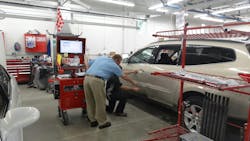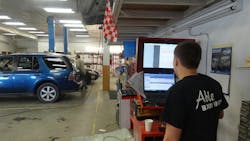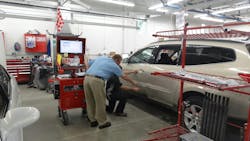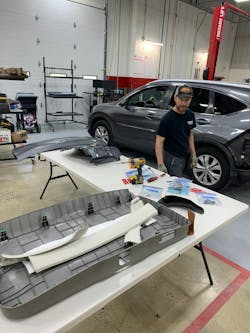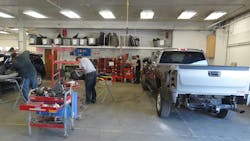As AI takes root in our world, we all sense the risk it might pose if taken too far. But in this article, we want to challenge you to embrace AI estimating for nearly all estimates as soon as possible. That bold statement begs an explanation, and this article aims to support the conclusion that all vehicles should be assessed with AI estimating.
Assignment to Inspection
Statistically, according to CCC, the industries’ DRPs miss out on 27% of the opportunities on assignments because customers don’t get called in a timely manner and choose to go elsewhere. This means we miss 27% of the work assigned to us that should be a lay-up. You can engage AI through Body Shop Booster or another provider to secure those assignments and get accurate customer information. They actually follow the script and attempt to get a commitment to show up for an “inspection.”
As your staff (or the AI resource) makes initial contact with potential customers, it is important to express empathy and take control of the call and gather basic customer and vehicle information. Then the new AI estimating process takes center stage. To triage the job, it is crucial that you communicate to the customer how important /valuable it is to get solid images of the vehicle’s four corners and of the damage to the vehicle from a few angles.
Images for the Initial Inspection
Once these images are received electronically, we suggest they be assigned to someone to create a preliminary inspection report. CCC has launched JumpStart, and Body Shop Booster has integrated Tractable (and Mitchell and Solara have announced plans to be equipped with a similar product in the next few months) to help write these AI estimates for us. The target is to save your staff the time to write 85-90% of the estimate lines off the images to evaluate the job’s type, assess how many panels need repair (if that is how you determine job type), and the relative size of the job in labor hours.
This initial AI inspection report can do a few valuable things:
Help triage the level of damage the vehicle has incurred.
- Minor or small repair (one to two panels) – Initial inspection can be provided and painted parts ordered for arrival when the vehicle arrives
- Medium repair (two to four panels) – The vehicle is scheduled for an “advanced inspection” (possible minor disassembly, like they do in the UK) to determine the extent of damage, but the basic inspection report can be generated by AI
- Large or heavy Hits – (three or more panels) You can use the images to prewrite the inspection report so the vehicle repair cost can be estimated to determine if the vehicle is a total. If not, it saves 80% of the time it takes to write the eventual advanced inspection report.
You can use the images and AI estimate to determine which panels will need to be repaired or replaced and how many will require paint work.
Once you get them comfortable with having your repair center do the work, you can then solicit a signed work authorization and preorder parts. NOTE: Have the customer sign a work authorization and provide a credit card advanced authorization to minimize cancellations.
The assumption is you have subsequently worked to schedule the repair in any of the three forms:
- Provided a firm price and sold the minor repair customer on scheduling the repair
- Scheduled the medium repair in for an “advanced inspection”
- Had the vehicle towed to your repair center (and then add it to the schedule).
Advanced Inspection Process
With the assumption that the time that used to be invested in writing an “estimate” has been minimized using AI estimating and the advanced inspections are scheduled, we want to set the expectation that we have written a basic estimate. But we still may take 20-45 minutes to dig a bit deeper to assure we accurately capture all the damage using borescopes, mirrors, and performing minor disassembly to get a fairly accurate assessment. Also, while on site it is important to use the paint spectrophotometer to determine the color and any special circumstances (quad, limited-use toners, pearl, etc.). Next, it’s up to a designated person to use these inspections to guide which OEM procedures to research to then attach to the RO file for the technicians to utilize. Then, the AI estimate is updated now that you have more clarity as to the types of damage you are repairing.
Pre-order Parts on all Vehicles on the Schedule
With parts availability cited as the biggest challenge during the repair planning and body repair process, we need to seek ways to get these parts coming to the shop ASAP.
After an AI estimate is written and the advanced inspection enhances it, we want to source all the parts which are obviously damaged. This allows the dealer to get these parts as part of their “stock order” and time to source them from distant places to assure they are on site when the vehicle arrives on the scheduled date.
Definition of a Critical Part
A “critical part” is any part needed to complete tasks in the next downstream department. This most often implies that the larger complex assemblies must be there before the vehicle arrives. That means that during morning release meetings, the parts manager needs to have confirmed the critical parts are there for vehicles arriving over the next two days so we don’t have customers dropping off vehicles for which we don’t have “critical parts” to begin repairs. If customers knew we didn’t have the parts and we inconvenienced them by dropping off their vehicle, they wouldn’t be too happy.
Receiving Process – Pre-scan, Pre-wash, and Initial On-vehicle Notes
As customers drop off their vehicle at the scheduled time, it’s very important to move the vehicles from the arrival area to an area where you attach the pre-scan tool and check the bulbs/dash lights while the staff install floor and seat mats and then prewash the vehicle to make prior unrelated damage more obvious to see and minimize dirt in work areas and in technicians’ eyes. Once the vehicle is put in the pending repair plan area, it can be prioritized (either by job size or the sequence of which the technician assigned to the job should begin the process) to ensure repair planning can begin as soon as possible.
Often, during this pre-repair planning phase, the parts are 720-degree (inside and out inspection) mirror-matched and then the complex painted assemblies are sent to Paint (with a card listing all the loose parts to be painted and paint code) to be painted on both sides with other vehicles to optimize booth cycles.
Transfer of the Parts during Repair Planning
This is where the AI assessment and advanced inspection process they support (including pre-ordering of parts) pay off in time savings… Vehicles are then taken to the Repair Planning work area or to the stall of the technician who may eventually perform the repair along with the painted parts which have been pre-painted so the transfer process can begin. Another key process to add is to rough-pull sheet metal (or attempt a plastic repair) for which you are unsure you can repair or replace the part. And pre-pull the frame to get an accurate record of what the vehicle will need. Further, a detailed mechanical diagnosis (on a lift) should be performed to minimize later concerns.
Technicians are now way more willing to 100%-disassemble the complex assemblies because they can transfer the R & I part to the parts pre-painted as the vehicle arrives. It is during this parts transfer process that the true magic occurs. It is during this preliminary reassembly process that technicians begin to see the missing, lost, broken, or damaged parts which are needed at reassembly. They can test bulbs or other components for function which may normally be caught after the repair is near completion.
Also, much of the time invested (possibly wasted, depending upon your perspective) bagging and tagging parts is largely unnecessary. The on-vehicle notes guide the visualization of the remaining repair processes to speed the body repairs, painting, and reassembly process.
The key to repair planning is, “Have you answered all the questions you can to ensure the need for a second supplement is eliminated or at least minimized?” If so, we can save time waiting for parts during reassembly and can improve overall hours per day working.
What are the Biggest Benefits of Using AI to Aid the Repair Planning Process?
Looking back, then, the key to this entire refined process is the AI estimate, which saves us time in assessing the damage, triaging the repair level for scheduling of advanced inspections or repairs, and ultimately helping us get the customers authorization to trigger the pre-order of the parts. Once these critical parts arrive, they can be pre-painted and then parts can be transferred during repair planning. All these elements help minimize the question marks which may lead to a second, third, fourth, or more parts orders/supplements.
About the Author
Steve Trapp
Steve Trapp is an internationally known consultant and speaker. His family operates a collision repair center in Wisconsin. He earned a degree in economics education and a minor in accounting from the University of Wisconsin.
After college, he worked for 3M in sales and marketing roles with the innovative 3M ARM$ training and software sales. He worked as a consultant for AutocheX doing financial consulting for a few years before joining AkzoNobel, where he started the industry’s first value-added program. While there, he started the industry’s first paint company-sponsored 20 groups and wrote numerous training programs with third-party experts on finance, marketing, selling, leadership, and other topics.
He later joined DuPont/Axalta, where he worked with Mike Anderson to manage their 20 groups and industry seminars. While at Axalta, he managed the North American Strategic Accounts SAM team and later the entire EMEA Strategic Accounts team. He followed that as senior consultant for LEAP, a global consulting firm that has presented in 10 countries and now again works for a major paint company.
